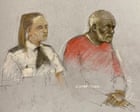Neighbours of a Bristol woman raped and murdered in her own home almost 60 years ago told police they heard screams and moans on the night of her death, a jury heard.
However, they said they did not think the noises were coming from the house of 75-year-old Louisa Dunne and went back to sleep, the court was told.
Fifty-eight years after Dunne’s death, a 92-year-old man, Ryland Headley, is standing trial for her rape and murder after advances in DNA allegedly established a link between him and the crime. He denies the offences.
On day two of his trial at Bristol crown court, the statements neighbours gave to police in the summer of 1967 were read out. The jury was told the witnesses were all “dead or presumed dead” – so their only possible testimony was their statements.
Alice Clarke, the first witness whose evidence was read, described Dunne as her “best friend” and told how she had been married to a “leading light in the Labour party”, Edward Parker, who had died by 1967.
Clarke last saw Dunne on the evening of 27 June 1967 when her friend paid a visit. Dunne went home at about 7.30pm and was in “good spirits”.
Dunne’s neighbour Violet Fortune said in her statement that she went to bed at 11.45pm. “I was wakened suddenly by what sounded like a scream,” she said. “It was not a long, piercing scream, but a crying out. It sounded muffled and I thought it came from the street outside.”
She looked out but saw no one and got back into bed. “I had been in bed for about two minutes when again I heard someone cry out. I could distinguish it was the voice of a woman. The cry lasted for two or three seconds and I was aware at the same time of a voice. I cannot say if it was a man or woman.” She did not think it had come from Dunne’s house.
Another neighbour, Harold Hodson, said: “I heard a loud scream. It was a frightening scream. It was an adult woman. It sounded as if someone was being attacked. After the scream there was a sound of moans or as if the sound was being muffled.” He put it down to a man he knew beating his wife. The sound stopped and he went back to sleep.
Next morning, neighbours became worried when they did not see Dunne and noticed that a sash window at her house was open. One, Violet Allen, climbed in and found her body. “She was as cold as ice,” she told police.
The jury heard how police took samples from the scene and preserved Dunne’s clothes and belongings.
In a statement from 1967, also read to the jury, DI Albert Abel listed items handed to him by a forensic pathologist, including the blue skirt Dunne had been wearing when she was found. He took these to a Home Office forensic science laboratory in Bristol.
The prosecution alleges semen found last year on Dunne’s skirt, when police looked again at the case, matched Headley’s DNA. It claims the match ratio meant it was a billion times more likely to be Headley’s DNA than that of anyone else.
The trial continues.
